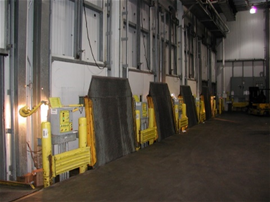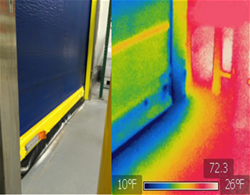In our previous blog on Good Design Practice: “Lead Design without the LEED Program”, we discussed how Production and Distribution buildings can be designed to green and sustainable standards without using the LEED Program. We discussed how Design Group’s many years of experience have led to highly efficient buildings for these categories.This includes superior building envelopes, and efficient MEP systems. Our design approaches for electrical and mechanical systems results in energy efficient buildings at an optimized cost.
This blog post lists those design practices that enable higher energy efficiency thus, lower energy costs for Production and Distribution Facilities. Read on.
Design using “air barrier” technology

Air Barrier technology is intended to eliminate air currents in a building’s exterior envelope which is the prime cause of condensation, which reduces a building’s effective R value and overall thermal performance. This technology has been around for years but is taking hold in building design replacing the previously dominant vapor barrier approach.
A vapor barrier, or vapor retarder is designed to slow or prevent diffusion of vapor out of or into a building, depending on the climate in which the building is located. If there is too much diffusion of vapor, condensation can occur in the building’s envelope.
An air barrier is designed to prevent air leakage into or out of a building which is influenced by differential pressure. When leaks occur in the building envelope, air currents are generated leading to condensation in the exterior envelope. One goal when implementing this approach is to make the air barrier continuous, tying the wall barrier to the under slab and roof barriers, the door and window frames and other opening frames.
The International Energy Conservation Code now requires materials in envelopes to have a maximum perm rating. This is the rate at which a material allows vapor to diffuse. The IECC also has a maximum allowable air leakage for the exterior envelope assemblies. Combined, these ratings guide designers in selecting the best materials for a building’s envelope, be it walls, floors or roofs.
Enforce good door and window management
 Managing how often exterior doors are opened and for how long is another key to lowering energy costs. This is especially true at dock doors which can be plentiful in warehouses and production facilities. Keeping doors and windows closed as much as possible, especially around a cold storage facility dock saves money.
Managing how often exterior doors are opened and for how long is another key to lowering energy costs. This is especially true at dock doors which can be plentiful in warehouses and production facilities. Keeping doors and windows closed as much as possible, especially around a cold storage facility dock saves money.
There are a number of options available to assist in this effort. They include choosing the right doors. Sectional overhead doors are most commonly used at docks but they are not always the best choice.
A single panel vertically operating door can reduce infiltration and when combined with a continuous dock pit and vertical storing levelers, one can realize significant savings.
Use night doors in cold storage rooms that see heavy daytime traffic
 Night Doors are doors that close off cold rooms when there is little or no traffic passing through. These are doors with a high R value and tight seals. They are typically used in conjunction with rapid opening traffic doors which often have low R values and are not known for their seals.
Night Doors are doors that close off cold rooms when there is little or no traffic passing through. These are doors with a high R value and tight seals. They are typically used in conjunction with rapid opening traffic doors which often have low R values and are not known for their seals.
The rapid doors are used when there is heavy traffic passing through, usually fork trucks and most commonly during daytime hours. The rapid opening doors include rapid rolling, fast-folding and bi-parting style doors. These move quickly, allowing fork trucks to pass through the opening while limiting the time a door is open.
Perform a thermal image scan of your facility to find and eliminate leaks
 This is a cost effective way to improve any facility whether new or old. Using a thermal imaging camera leaks can be found in a building’s envelope that can be costing a building owner. Many times the leaks are small and easy to eliminate using the appropriate sealant materials.
This is a cost effective way to improve any facility whether new or old. Using a thermal imaging camera leaks can be found in a building’s envelope that can be costing a building owner. Many times the leaks are small and easy to eliminate using the appropriate sealant materials.
Design Group has used thermal imaging to locate leaks and as a forensics tool. Reports are ultimately generated identifying the issues at a facility and the recommended procedures to eliminate them. Past cases include clients who were experiencing condensation leaking from production room roofs and clients struggling to hold a particular cold room temperatures critical to their food production procedures.
Contact Design Group if you would like to discuss how to implement any of these energy saving practices or to request a full facility assessment. We are just a phone call away. Click here to send a request.